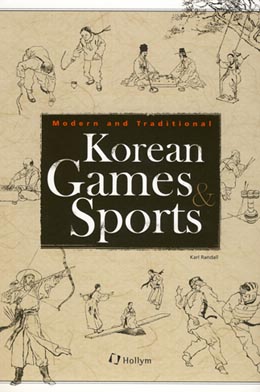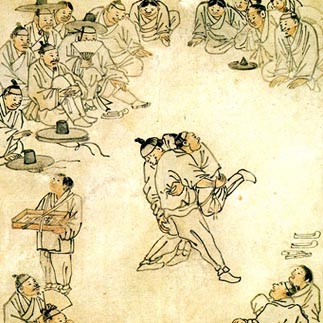Inside scoop on Korean games and sports

There are many books in English about Korean culture but only a handful have tackled the topic of Korean folk games and sports.
The recently published book “Modern and Traditional Korean Games and Sports” by professor and historian Karl Randall provides valuable insight into both, with enough historical anecdotes to keep sports enthusiasts interested and novices wanting more.
While the term culture can be understood in a rather broad and ambiguous context, learning about a nation’s games and sports could perhaps be a good first step towards understanding its culture and heritage.
Randall, a full time lecturer who teaches foreign students about Korean culture, seeks to explore through sports in his new book.
Written in English, the book’s strong point is that it provides detailed descriptions in a manner that is simple and easy to understand.

Joseon-era artist Kim Hong-do’s painting of ssireum, a traditional sport. [JoongAng Ilbo]
In the first section, the author introduces traditional games like tuho (arrow toss), neolttwigi (seesaw) and more. These games, Randall writes, are “disappearing from modern existence in Korea” and he hopes that “readers help preserve them, if not in practice, then at least in memory.”
Illustrated with colorful drawings that conjure up the drawings found in Korean textbooks, the book also provides a striking visual aid to give readers a more three-dimensional picture of the activities described.
The second section focuses on popular games still enjoyed by Koreans today and offers detailed instructions on the rules with realistic drawings of the game boards.
There is a clear and easy to follow description of baduk (Korean chess) and hwatu (Go-Stop), a favorite card game enjoyed among family and friends. The section on hwatu is particularly useful, because it has color images of the cards and descriptions of how they are matched in play.
The last section invites readers to explore the origins of traditional sports like gukgung (Flight Archery), ssireum (wrestling) and the martial arts taekkyon and Taekwondo.
Randall wrote the book after being asked to teach a class on games and sports at his university, but, as he notes in his introduction, in the course of doing his research he found that other books on the topic were either too academic or too simplistic for the average reader. That makes his book a particularly valuable resource, the first to be published in such a concise and compact form in English.
According to the biography in the book, Randall is a full-time lecturer at Kyungsung University in Busan, where he teaches classes dedicated to introducing Korean culture to exchange students.
Korean Games and Sports
Author: Karl Randall
Genre: Culture, history
Publisher: Hollym
By Chang Hye-won Contributing writer [estyle@joongang.co.kr]










with the Korea JoongAng Daily
To write comments, please log in to one of the accounts.
Standards Board Policy (0/250자)